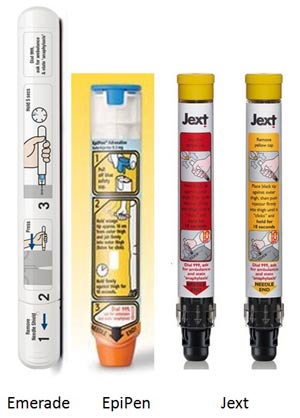|
|
Adrenaline Auto-injectors explained - Which one do you use? |
|||||||||||||||||||||||||||||||||||||||||||||||||||||||||||||||||||||||||||||
|
These two articles originally appeared in Ruth's Allergy Diary in February 2014. Ruth Holroyd suffers froma wide range of allergies, many life threatening. She ruys her own blog at What Allergy? |
|||||||||||||||||||||||||||||||||||||||||||||||||||||||||||||||||||||||||||||
|
If you carry an adrenaline auto-injector (AAI) you might be interested to hear about the differences between the three main competitors in the UK market. EpiPen is distributed by Meda Pharmaceuticals, Jext is produced by Alk Abello and Emerade is distributed by iMed Systems Ltd and will be available on prescription from February 2014. AnaPen used to be prescribed but hasn’t been available in the UK since February 2012 and they have no plans to supply the UK at this point.
There have been some concerns about the requirement for a needle which will penetrate the thigh sufficiently to reach the muscle. Some doctors think that this is necessary for the adrenaline to work effectively. Whilst the JEXT and the EpiPen have 16mm I would urge you all to make sure that you, your friends and your family know how to use your adrenaline injector. Request a free training device and then practise, practise, practise! Make your friends and family practise on you too. I am proof that in a stressful situation, when you are having a reaction, you don’t always do the right things in the right order. (See my near fatal experience here.) Remember that all these devices are for emergency first aid only. If you need to use one, you must also get emergency medical care. Dial 999, ask for ‘ambulance’ and say ‘anaphylaxis’. So… go to the websites below and see what you think. You may not get much choice which pen you’re prescribed. The decision may be made by your local NHS Health Partnership, probably based on cost and shelf life, but what if we could have a choice?
Which one would you prefer? And let’s hope you never have to use it!
More thoughts on auto-injectors.... Just do it! Don’t panic. Use your auto-injector and phone 999... Since comparing Emerade, Epipen and Jext in the last newsletter I wondered how you all felt about yours. Do you feel comfortable using it? Are you scared of using it?
My throat and tongue swell up so badly when I have anaphylaxis and the asthma makes it almost impossible to speak. At what point during these extreme allergic reactions did my brain compute that it was best not use my injector and get help? For more details on surviving and attack an d on how to write an Action Plan see Ruth's article here. 2014 If you found this article interesting, you will find many more articles on anaphylaxis here, and reports of research into anaphylaxis here.
|
|||||||||||||||||||||||||||||||||||||||||||||||||||||||||||||||||||||||||||||

 All three injectors now have a needle shield which protects your fingers after use. This is now required following quite a few needle injuries reported by users.
All three injectors now have a needle shield which protects your fingers after use. This is now required following quite a few needle injuries reported by users. 










